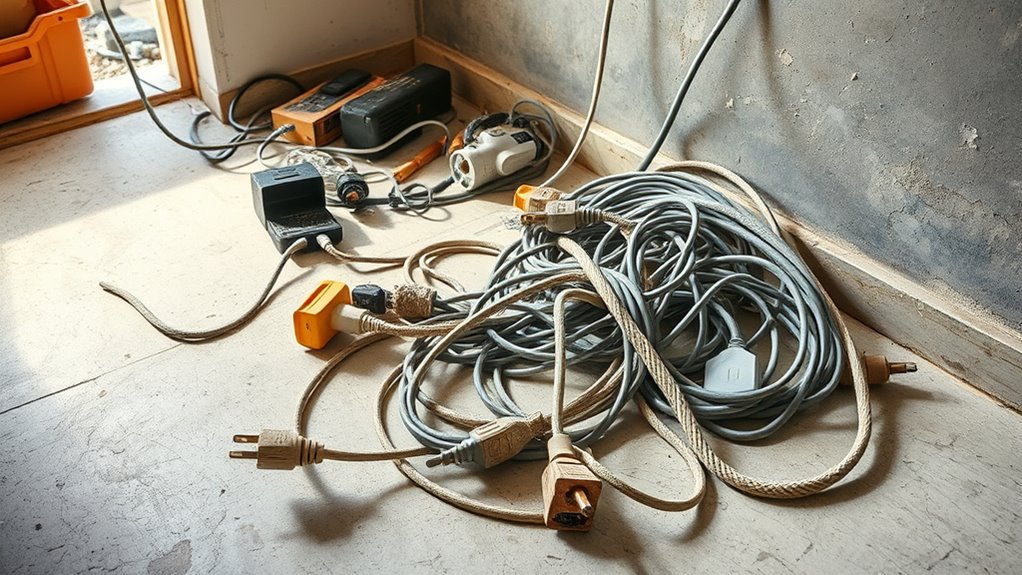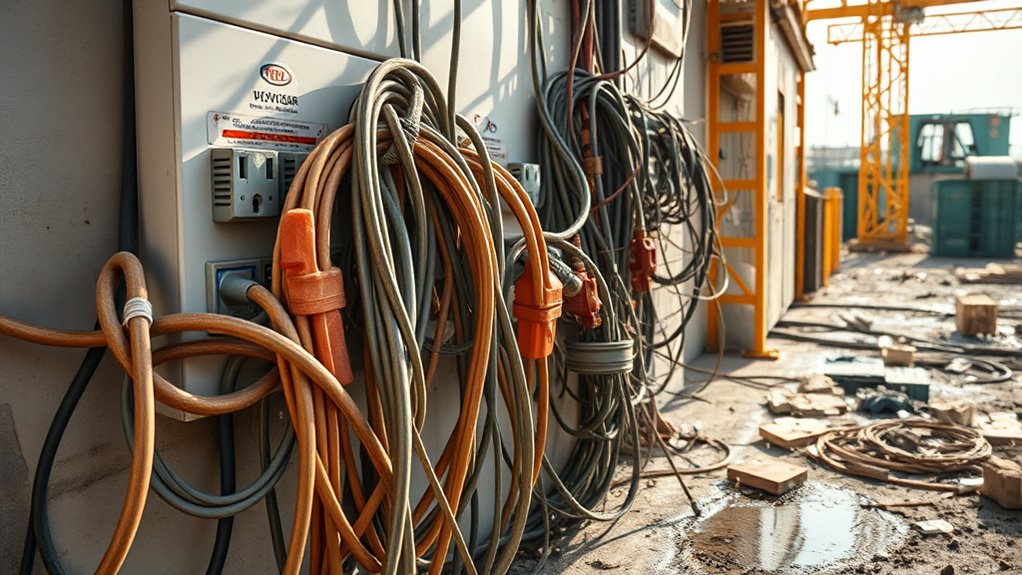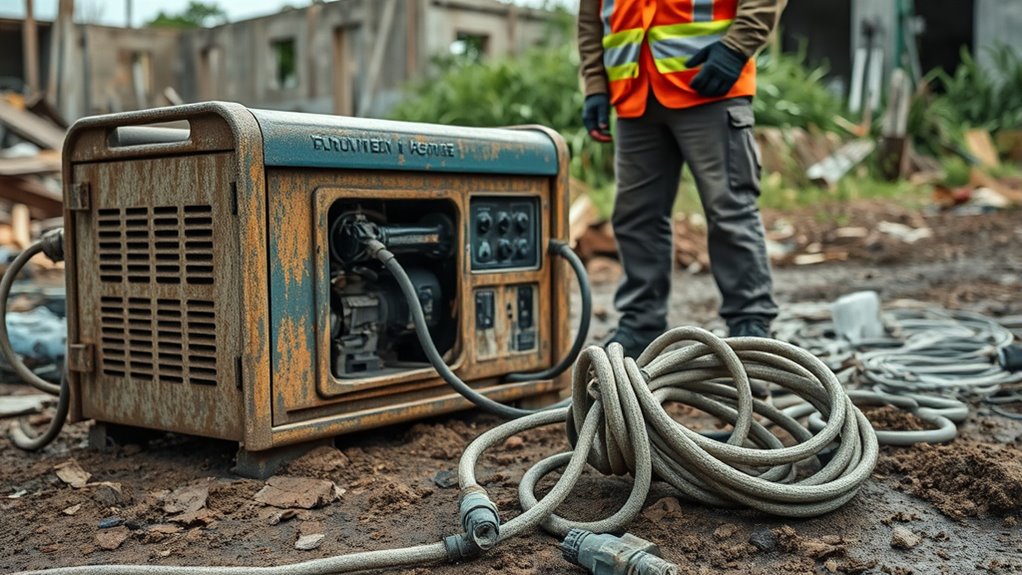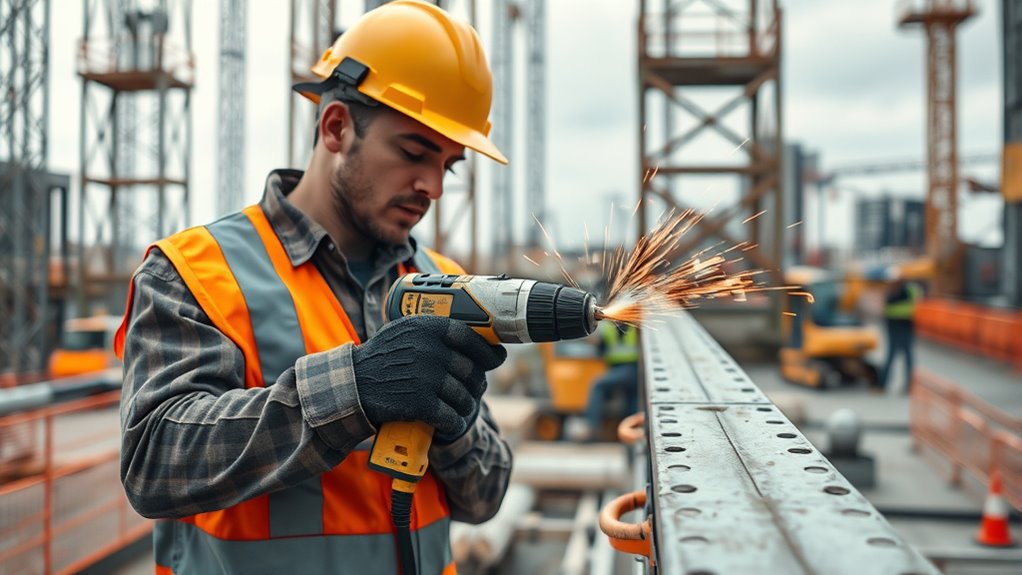To avoid jobsite power issues, you should organize cords properly using straps or clips, preventing tripping hazards and cable damage. Don’t overload circuits or rely on extension cords as permanent power sources, and always check your equipment’s capacity. Regular inspections, maintenance, and using the right tools for each task help prevent equipment failure. Finally, follow safety protocols and wear appropriate PPE—ignoring these steps risks accidents. Keep these tips in mind to stay safe; more details follow.
Key Takeaways
- Organize cords with clips or straps to prevent tripping hazards and cable damage.
- Avoid overloading circuits and use proper power sources to prevent electrical failures and fires.
- Conduct regular inspections and maintenance of equipment to identify wear and prevent hazards.
- Select equipment suited to the job’s electrical requirements to ensure safety and efficiency.
- Always follow safety protocols and wear appropriate PPE to protect against electrical and physical injuries.
Neglecting Proper Power Cord Management

Neglecting proper power cord management can lead to serious safety hazards on the jobsite. When cords are left tangled or strewn across walkways, tripping hazards increase, risking injuries and equipment damage. Effective cord management is essential to keep cables organized and out of the way. Use cable organizers, straps, or clips to secure cords neatly along walls or workbenches, preventing accidental pulls or disconnects. Proper cable organization also reduces wear and tear on the cords, extending their lifespan and maintaining safety standards. Always inspect cords regularly for damage, and replace any frayed or worn-out cables promptly. Additionally, understanding the importance of sleep and mental health can improve overall alertness and safety awareness on the jobsite. By prioritizing cord management and cable organization, you ensure a safer, more efficient work environment, minimizing the risk of accidents related to power cords.
Overloading Circuits and Power Sources

Overloading circuits and power sources can quickly lead to dangerous electrical failures on the jobsite. When you exceed the capacity of a circuit, you risk a circuit overload, which can cause wiring damage or fires. To guarantee power source safety, avoid these common mistakes:
Overloading circuits risks wiring damage, fires, and dangerous failures on the jobsite.
- Connecting too many high-power tools to a single circuit.
- Using extension cords as permanent power sources.
- Ignoring the amperage ratings of outlets and devices.
- Overloading power strips beyond their rated capacity.
- Failing to recognize the importance of proper power management in maintaining electrical safety.
Always check the circuit’s load capacity before plugging in equipment. Use multiple circuits when necessary, and never bypass safety features. Proper power management prevents circuit overloads, reducing the risk of electrical failures and accidents. Prioritize power source safety to keep your jobsite secure and compliant.
Ignoring Regular Equipment Inspections and Maintenance

Regular inspections and maintenance are essential to guarantee your equipment operates safely and efficiently. Skipping these steps can lead to unexpected breakdowns, safety hazards, and costly repairs. Use an inspection checklist regularly to catch issues like worn cords, loose connections, or damaged components early. Adhering to a strict maintenance schedule ensures that filters, lubricants, and parts are replaced before failure occurs. Ignoring these routines increases the risk of electrical faults, fires, or equipment failure on-site. Proper maintenance, including filter replacement, is critical for maintaining optimal air quality and equipment longevity. Consistent inspections help you identify potential problems before they escalate, saving time and money. Make sure to document all inspections and maintenance activities, so you stay compliant and aware of your equipment’s condition. Proper care keeps your jobsite safe and keeps your power tools running smoothly.
Using the Wrong Equipment for the Job

Choosing the appropriate equipment for a specific task is essential to guarantee safety and efficiency on the jobsite. Using the wrong equipment can lead to accidents, delays, and damage. To ascertain proper tool selection and equipment compatibility, consider these points:
- Confirm the tool matches the job requirements.
- Check that electrical ratings and power sources are compatible.
- Avoid overloading or underpowering equipment.
- Ensure safety features are present and functional.
- Be aware of performance capabilities, ensuring the equipment can handle the workload safely and effectively.
Failing to Follow Safety Protocols and PPE Guidelines

Failing to follow safety protocols and PPE guidelines puts everyone on the jobsite at risk. Proper PPE, such as hard hats, gloves, eye protection, and steel-toed boots, is essential to prevent injuries. Overlooking safety protocols can lead to accidents, injuries, or even fatalities. Always wear the appropriate PPE for each task, and don’t skip safety briefings or procedures. Ignoring these measures compromises your safety and that of others around you. Make it a habit to verify that your PPE is in good condition and fits properly. Remember, safety protocols are designed to protect you from hazards, electrical shocks, and falling objects. Studies show that optimal angles can improve game longevity and reduce the risk of damage to your equipment, emphasizing the importance of adhering to recommended setups. By adhering strictly to safety guidelines, you reduce the chances of costly accidents and create a safer work environment for everyone.
Frequently Asked Questions
How Can I Identify Signs of Electrical Overload On-Site?
You can identify signs of electrical overload on-site by paying attention to warning signs like frequent circuit breaker trips, overheating outlets, or burning smells. A circuit overload occurs when too many devices draw power from the same circuit, causing it to overheat. If you notice flickering lights or sparks, stop using the circuit immediately. Regularly inspecting your electrical system helps prevent overloads and keeps everyone safe.
What Are the Best Practices for Organizing Power Cords Safely?
While chaos may seem inevitable on a busy jobsite, proper cord management keeps hazards at bay. You should coil extension cords neatly, avoiding tangles that can cause tripping or damage. Use cable covers or hooks to keep cords off the ground, and never overload extension cords. Prioritize extension cord safety by inspecting cords regularly for damage, and always unplug cords when not in use. Good organization minimizes accidents and keeps your jobsite safe.
How Often Should Power Tools Be Inspected for Safety?
You should inspect your power tools daily, especially before use, to guarantee safety and proper tool maintenance. Regular checks help identify issues like frayed cords, loose parts, or damaged switches that could compromise operator safety. By making safety inspections routine, you reduce the risk of accidents and keep your tools in ideal condition, ultimately protecting yourself and others on the jobsite. Always follow manufacturer guidelines for specific inspection intervals.
What Training Is Necessary for Proper PPE Use?
Think of PPE as your trusty shield—without proper training, it’s only a piece of fabric. You need hazard awareness training to understand how to select, properly wear, and maintain your personal protective gear. This training helps you recognize potential dangers and guarantees you’re prepared to respond effectively. By mastering PPE use, you turn your gear into an active defender, safeguarding your health and keeping hazards at bay.
How Do I Choose the Right Equipment for Specific Tasks?
To select the appropriate equipment for specific tasks, start by considering the power source selection to guarantee it matches your job’s energy needs. Check equipment compatibility with your existing tools and power supplies to avoid malfunctions. Assess the task’s requirements carefully, choosing tools designed for that purpose. Always consult manufacturer guidelines and safety standards to ensure peak performance and safety, preventing unnecessary risks on the jobsite.
Conclusion
Think of your jobsite as a carefully tended garden. If you neglect proper power management, overburden circuits, skip inspections, choose the wrong tools, or ignore safety protocols, weeds and pests can take over, threatening the entire landscape. But by tending to each detail with care and precision, you’ll cultivate a safe, efficient workspace where every tool and circuit blooms in harmony. Keep these mistakes in check, and your jobsite will flourish.









